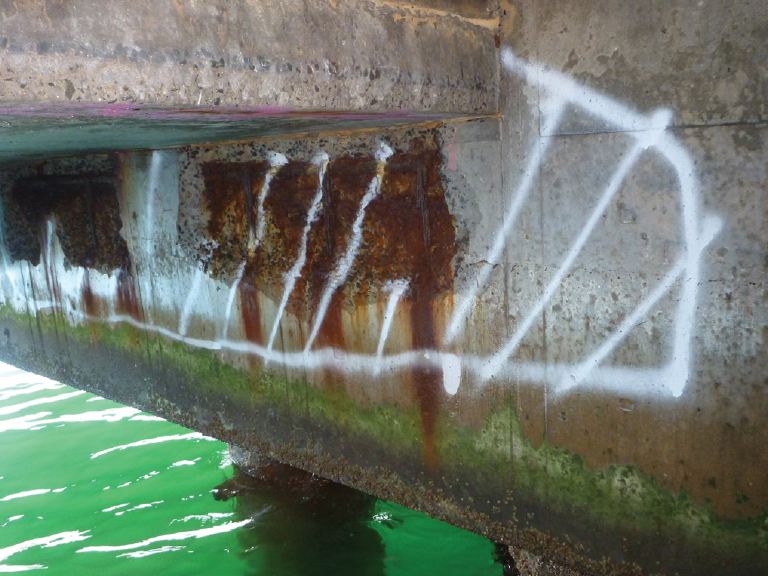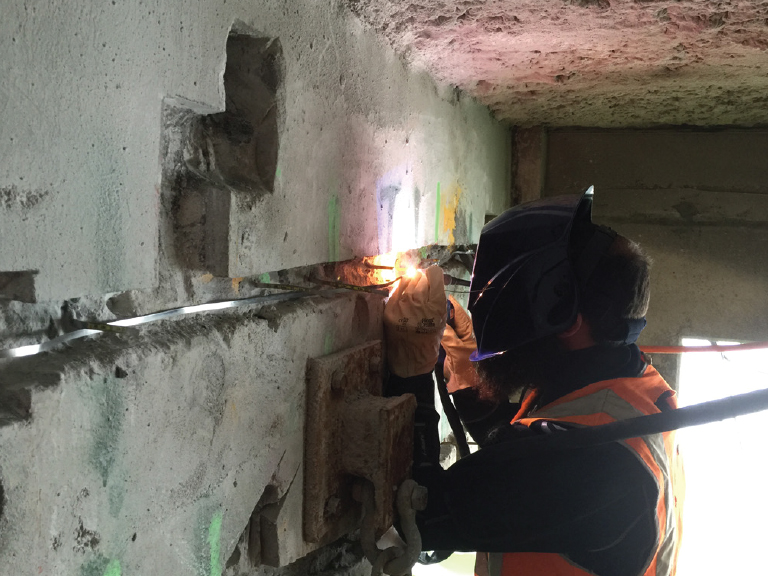WEBB DOCK EAST WHARF REHABILITATION
Typical spalling and delamination of a transverse beam. The total estimated spalling repair area ~2000m2.
Half cell potential plots on the face of each beam incorporating spalling and delaminated areas and chloride, corrosion rate and resistivity testing to assist in the anode arrangement design. A typical arrangement of discrete anodes on a beam is shown above.
Discrete anodes installed into the beams with the anode titanium ‘tails’ finally welded to the titanium conductor to form the CP zone.
The concrete and water anode control systems are AC powered and “distributed” below the wharf deck, thus maximizing the power efficiency of the system and minimizing the cost of cabling.
Webb Dock East Wharf Rehabilitation
CLIENT: PORT OF MELBOURNE CORPORATION
Since Melbourne’s foundation in the 1830s, the Port of Melbourne has handled general and bulk cargo with the volume of imports and exports consistently increasing each year. This port pioneered the handling of containers and is now Australia’s largest, handling almost 40% of the nation’s sea trade traffic. Not only is it of great value to the Victorian State but it is also critical to the national economy considering trade forecasts and growing demand.
CHALLENGES
Webb Dock East wharves 4 and 5 were constructed in the late 70’s. When Port of Melbourne Corporation required the wharves to be rehabilitated and upgraded to ensure their ongoing functionality for a further 30 years, Infracorr Consulting Pty Ltd (Infracorr) was engaged as a subconsultant to Jacobs Group (Jacobs) to provide specialist engineering services.The four key challenges identified by Infracorr were:
• The inspections and testing under the wharves would be in a confined environment with the need to adapt to shipping movements, the prevailing winds and the resultant wave action, thus presenting significant safety issues and requiring specific skills to complete the survey seamlessly.
• The project would require extensive testing to ensure sufficient information was available for Infracorr to design repair and protection systems for both the concrete and the steel members, the designs each requiring durability management planning considerations.
• The residual thickness of the Steel Piles and Steel Pile walls both above and below the water needed to be assessed via Ultrasonic Thickness Testing (UTT) so that Jacobs could design the requirements for the structural upgrades for the wharves.
• The scope of the condition assessment had to be such that the outcomes would be sufficient for a repair contractor to provide the lump sum price when the works were tendered.
SOLUTION
To ensure that the Webb Dock East wharves 4 and 5 would achieve a further 30 years of ongoing functional life, Infracorr provided the following solutions:
• To battle the confined space environment during the condition assessment, Infracorr utilised small and mobile access pontoons able to easily and safety manoeuvred under the wharves.
• Several crews of specialist Infracorr engineers and professional divers ensured that all the concrete and steel elements both above and below the water were inspected and thoroughly tested within the required timeframe.
• Extensive Half Cell Potential surveys were performed on 25% of the 136 No. beams thus providing significant information upon which to design the ICCP systems.
• In excess of 25,000 UTT was performed on the 720 No. steel piles and 600m long steel sheet pile.
• The condition assessment performed by Infracorr was one of the largest ever performed in Australia and allowed Jacob’s to perform its structural upgrade assessment and design.
The design, specifications and construction drawings produced by Infracorr included an Impressed Current Cathodic Protection system to protect all the transverse beams and, an Impressed Current Water Anode Cathodic Protection system to protect the steel piles and the sheet pile walls below water. Both of these systems were designed to be remotely controlled for efficient monitoring of their performance.
• The design, specifications and construction drawings also included the requirements for concrete patch repairs, epoxy crack injection and silane coatings.
• The Durability Plan created provided information and recommendations to minimise maintenance during the next 30 years of the design life of the wharves.
• The extensive UTT performed allowed Jacobs to design strengthening systems for the steel elements which included welded steel plates and reinforced concrete pile jackets.
• The condition assessment and design by Infracorr allowed contractors to tender a lump sum price for the rehabilitation works.
Infracorr was also engaged to participate in the construction phase for this project. This required regular inspections and tests of the contractor’s works to confirm the quality, addressing issues that arose during the works, and validating the design.






